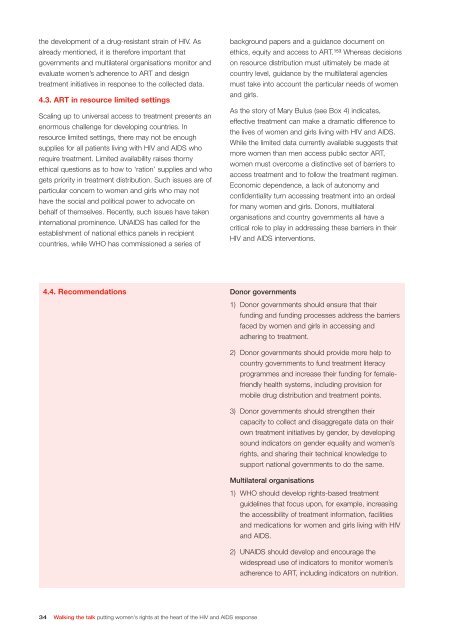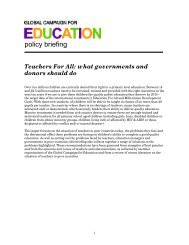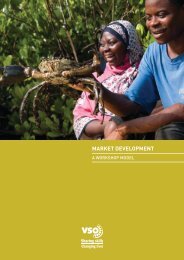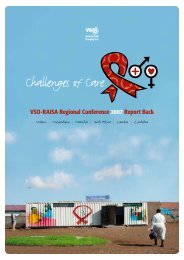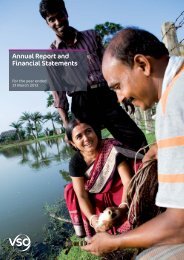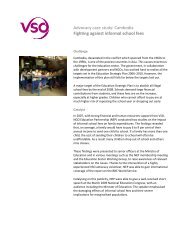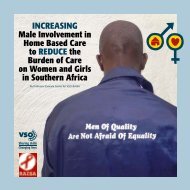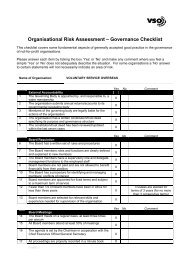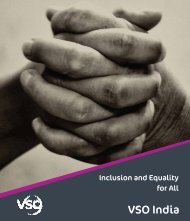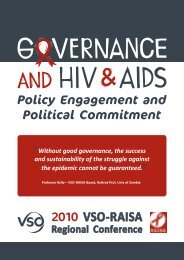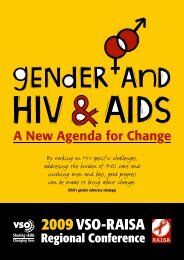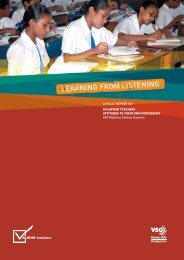Walking the Talk - VSO
Walking the Talk - VSO
Walking the Talk - VSO
Create successful ePaper yourself
Turn your PDF publications into a flip-book with our unique Google optimized e-Paper software.
<strong>the</strong> development of a drug-resistant strain of HIV. Asalready mentioned, it is <strong>the</strong>refore important thatgovernments and multilateral organisations monitor andevaluate women’s adherence to ART and designtreatment initiatives in response to <strong>the</strong> collected data.4.3. ART in resource limited settingsScaling up to universal access to treatment presents anenormous challenge for developing countries. Inresource limited settings, <strong>the</strong>re may not be enoughsupplies for all patients living with HIV and AIDS whorequire treatment. Limited availability raises thornyethical questions as to how to ‘ration’ supplies and whogets priority in treatment distribution. Such issues are ofparticular concern to women and girls who may nothave <strong>the</strong> social and political power to advocate onbehalf of <strong>the</strong>mselves. Recently, such issues have takeninternational prominence. UNAIDS has called for <strong>the</strong>establishment of national ethics panels in recipientcountries, while WHO has commissioned a series ofbackground papers and a guidance document onethics, equity and access to ART. 153 Whereas decisionson resource distribution must ultimately be made atcountry level, guidance by <strong>the</strong> multilateral agenciesmust take into account <strong>the</strong> particular needs of womenand girls.As <strong>the</strong> story of Mary Bulus (see Box 4) indicates,effective treatment can make a dramatic difference to<strong>the</strong> lives of women and girls living with HIV and AIDS.While <strong>the</strong> limited data currently available suggests thatmore women than men access public sector ART,women must overcome a distinctive set of barriers toaccess treatment and to follow <strong>the</strong> treatment regimen.Economic dependence, a lack of autonomy andconfidentiality turn accessing treatment into an ordealfor many women and girls. Donors, multilateralorganisations and country governments all have acritical role to play in addressing <strong>the</strong>se barriers in <strong>the</strong>irHIV and AIDS interventions.4.4. Recommendations Donor governments1) Donor governments should ensure that <strong>the</strong>irfunding and funding processes address <strong>the</strong> barriersfaced by women and girls in accessing andadhering to treatment.2) Donor governments should provide more help tocountry governments to fund treatment literacyprogrammes and increase <strong>the</strong>ir funding for femalefriendlyhealth systems, including provision formobile drug distribution and treatment points.3) Donor governments should streng<strong>the</strong>n <strong>the</strong>ircapacity to collect and disaggregate data on <strong>the</strong>irown treatment initiatives by gender, by developingsound indicators on gender equality and women’srights, and sharing <strong>the</strong>ir technical knowledge tosupport national governments to do <strong>the</strong> same.Multilateral organisations1) WHO should develop rights-based treatmentguidelines that focus upon, for example, increasing<strong>the</strong> accessibility of treatment information, facilitiesand medications for women and girls living with HIVand AIDS.2) UNAIDS should develop and encourage <strong>the</strong>widespread use of indicators to monitor women’sadherence to ART, including indicators on nutrition.34 <strong>Walking</strong> <strong>the</strong> talk putting women's rights at <strong>the</strong> heart of <strong>the</strong> HIV and AIDS response


